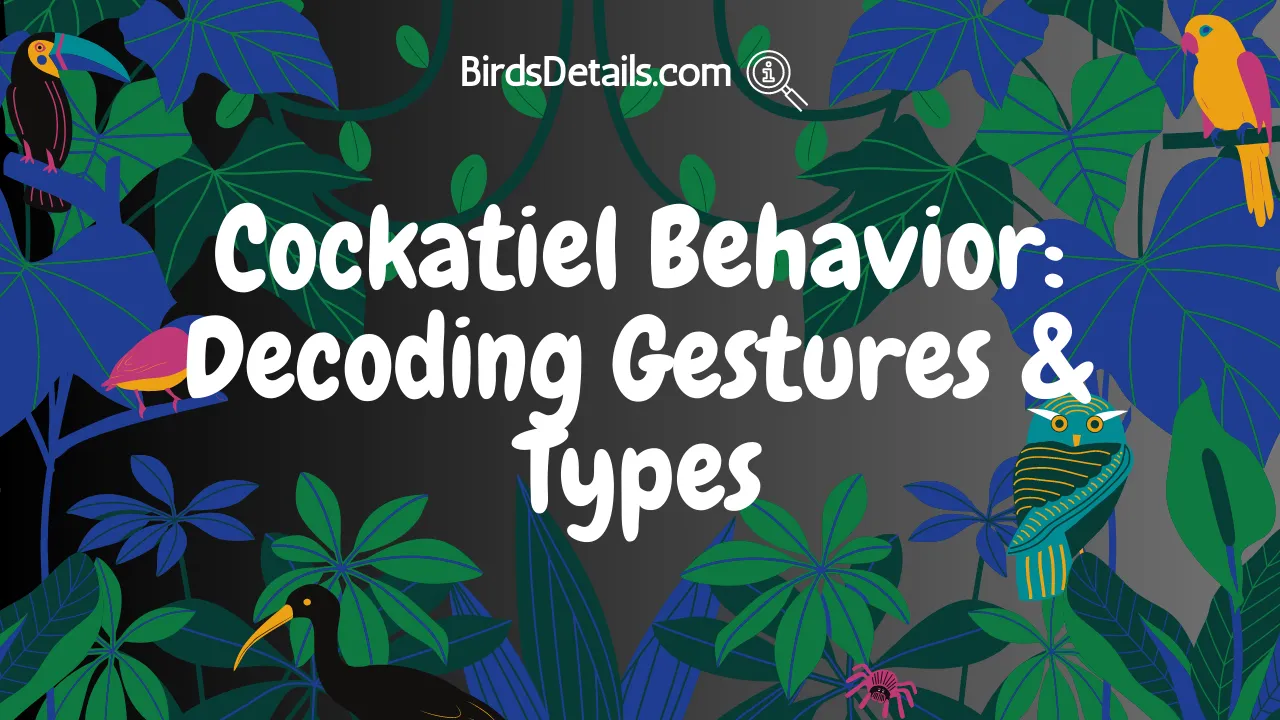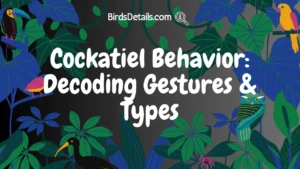Cockatiels are fascinating domestic birds that belong to the cockatoo family, a group of parrots known for their unique behaviors. Understanding cockatiel behavior is essential to keep your happy parrot healthy and well-trained.
From vocalization to preening and flocking, observing and interpreting cockatiel behavior can also help you identify any potential health issues or stressors in your environment. Whether you’re dealing with behavior problems in parrots of the cockatoo family, trying to understand why your cockatiel bites or beak bangs, or simply want to learn more about these social birds with their distinct tail feathers, this guide will provide you with the information you need.
So let’s dive into the world of parrot behavior and discover what makes these happy parrots so special within the larger cockatoo family. Certain behaviors, such as beak banging, also contribute to the unique characteristics of these birds.
Understanding different types of cockatiel behavior

Cockatiels are fascinating domestic birds that belong to the parrot family and come in a variety of colors and patterns. They are known for their playful and affectionate nature, but as a new bird owner, it’s important to understand that different species of parrots exhibit various types of behavior that can be confusing. Understanding these behaviors is crucial to providing better care for your pet.
Vocalization
One of the most common behaviors exhibited by cockatiels and parrots is vocalization. These birds are known for their ability to mimic sounds and words, making them popular pets among bird enthusiasts. Cockatiels and parrots use their beak to communicate with other birds and humans. They may chirp, whistle, or even scream when they feel threatened or scared. Feather plucking is a common issue among caged birds like cockatiels and parrots. It is important to provide them with spacious cages to prevent this behavior.
As a responsible owner of parrots, it’s essential to pay attention to their vocalizations and learn what they mean. For example, if your bird is screaming excessively, it may be a sign that it’s stressed or needs more attention. Feather plucking and beak grinding are also behaviors to watch out for, as they may indicate health issues or boredom. It’s important to provide your parrots with spacious and stimulating cages to prevent these behaviors from occurring.
Body Language
Another important aspect of parrot behavior is body language. These birds use their bodies and gestures to communicate with others around them. For example, if your bird is feather plucking, it may be a sign of abnormal behavior. Additionally, if your parrot is flapping its wings rapidly, it may be a sign that it’s excited or happy.
On the other hand, if your new cockatiel or parrot is hissing or puffing up its feathers, it may be exhibiting aggressive male cockatiel behavior or feeling defensive. It’s crucial to observe your bird’s body language so you can understand what it’s trying to tell you.
Feather Fluffing
Cockatiels, like other parrots in a flock, use gestures to communicate with one another. They also display feather-fluffing behavior when they’re relaxed or sleepy. This behavior involves the bird puffing out its feathers to make itself appear larger and more comfortable. Feather fluffing is a natural response that helps regulate the bird’s body temperature and keep it warm. However, excessive feather plucking can be a sign of stress or illness and should be addressed by a veterinarian.
As an owner of a male cockatiel, it is important to observe their flock behavior and cockatiel behavior closely. Take note if your bird shows excessive feather fluffing as it could be a sign of underlying illness.
Territorial Behavior
Like most parrots, cockatiels can be territorial. They may become aggressive towards other birds or humans if they feel threatened or uncomfortable. This behavior is especially common during mating season when the bird’s hormones are at their highest. Cockatiels should be kept in cages to prevent them from flying away and joining a wild flock. It’s important to provide a mate for your cockatiel to keep them happy and reduce their aggression towards humans.
It’s crucial to understand your parrot’s territorial behavior and avoid situations that could trigger aggression. For example, you should never approach a parrot while it’s in its cage or with its mate or flock.
Cockatiel Vocalizations: What They Mean
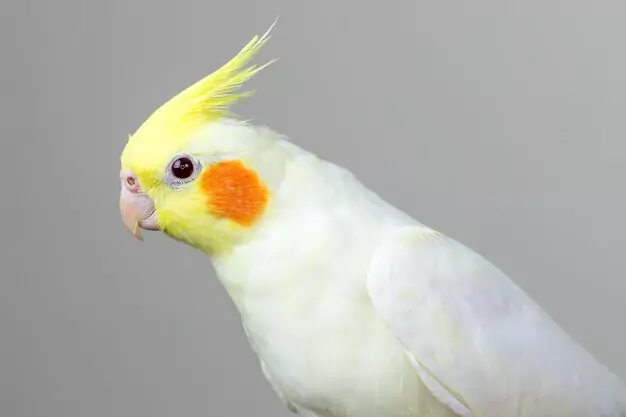
Cockatiels are a popular species of parrots often kept in cages as pets known for their vocalizations. These sounds can range from soft chirps and whistles to loud screeches and screams, which are used to communicate with their flock. But what do these vocalizations mean? In this article, we’ll explore the different types of cockatiel vocalizations and what they communicate.
Contact Calls
One of the most common vocalizations of parrots, including cockatiels, is the contact call. This high-pitched sound is used to locate other birds in their flock or to check in with their human caretakers through gestures. The contact call can vary slightly between birds, but it typically sounds like “cheap” or “chirp.” Cockatiels are often kept in cages, and they may become particularly vocal when seeking the attention of their mate.
If you have a flock of parrots, you may notice them using contact calls to find each other throughout the day. Similarly, if your new bird is out of sight or in another room, they may use a contact call to let you know where they are. Make sure to provide enough cages for all your parrots to prevent overcrowding and ensure they can communicate effectively through their contact calls.
Expressions of Happiness
Cockatiels, like most parrots, are social birds that thrive in a flock. They enjoy interaction with their owners, especially when they’re kept in spacious cages that allow them to move around freely. When feeling happy and content, they may make soft whistling or chirping sounds, accompanied by gestures such as head bobs or fluffed feathers.
If your cockatiel or any other parrots make these sounds or gestures when you’re interacting with them, it’s a good sign that they’re enjoying your company! This applies to both your old bird and new bird as they are social creatures who thrive in a flock.
Warnings
Like many bird species, including parrots, cockatiels have warning signals that alert others to potential danger. If your bird feels threatened or scared in their cage, it may emit a loud screech or scream and make gestures. These sounds and gestures are designed to startle predators and warn other birds in the flock of danger.
If your parrot or new bird makes this sound unexpectedly, take a look around their cage or flock to see if there’s anything that could be causing them distress.
Hunger and Thirst
Cockatiels, like other parrots, are active birds that require a lot of food and water to stay healthy. When they’re feeling hungry or thirsty, they may make specific vocalizations or gestures to let you know. It’s important to provide them with a spacious cage where they can move around freely, especially if they’re part of a flock.
If you notice your cockatiel or any new bird making these sounds, it’s important to check the food and water dishes in their cage to ensure that they have access to fresh supplies. This is especially crucial if you have a flock of parrots as they require consistent care and attention.
Mimicry
Some cockatiels and parrots can mimic human speech or other sounds in their environment. However, not all birds will develop this skill, and it may require training, gestures, and practice. Pet owners need to provide a comfortable cage for their feathered mate to encourage vocalization and mimicry.
If your new bird, such as a parrot or cockatiel, does learn to mimic sounds, it can be a fun way for you and your mate to communicate with them while they are in their cage. Just keep in mind that not all mimicked sounds will be appropriate for every situation!
Understanding your cockatiel’s vocalizations is an important part of being a responsible pet owner for parrots. By paying attention to the different sounds and gestures your bird makes, you can better meet their needs and build a stronger bond with them over time. It’s also important to ensure that their cage is suitable for their needs.
Cockatiel Body Language and Gestures: Interpreting Through Pictures
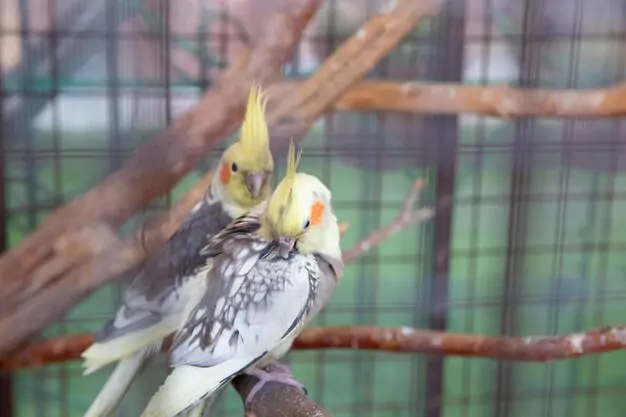
Cockatiels and parrots are social birds that communicate through a variety of body language and gestures. Understanding these signals is crucial to interpreting their moods and needs, especially when they are inside their cage. In this v4 article, we’ll explore some common signs to look out for when observing your cockatiel or parrot’s body language and gestures, as well as the benefits of using pictures to aid in interpretation. Step by step, you’ll learn how to read your feathered friend’s body language and provide the best care possible.
Signs to Look Out For
Cockatiels, like other parrots, have a range of body language and gestures that can indicate their mood or intentions. Some common signs include stepping up onto your finger or a perch, especially for a new bird, and exploring their cage.
- Fluffed-up feathers: This can be a sign of contentment or discomfort in parrots, including new birds. If your parrot is fluffing up its feathers while sitting in its cage, it may be trying to regulate its temperature or get comfortable. However, if it’s fluffing up its feathers while perched on your hand, it may be feeling threatened or uncomfortable and could be using gestures to communicate this.
- Hissing: Similar to parrots, hissing can indicate aggression or fear. If your cockatiel is hissing at you or another bird, it’s best to take a step back and give them space until they calm down. Also, observe their gestures inside the cage for any signs of discomfort or stress.
- Biting: While not always aggressive, biting can be a sign that your parrot is feeling stressed or uncomfortable. It’s important not to punish your bird for biting but instead try to understand what might have triggered the behavior. Observing their gestures and body language while they are in the cage can help you take the necessary steps to prevent biting.
- Relaxed body: A relaxed body with feathers lying flat against the skin indicates contentment and relaxation in parrots, including new birds. Understanding cockatiel behavior and gestures can help identify signs of relaxation in these birds.
Gestures to Watch For
In addition to body language, parrots like cockatiels use various gestures to communicate with their owners. Here are some common ones: If you introduce a new bird to the cage, it may take some time for it to step out of the cage and interact with you.
- Placing head upside down: This gesture is a common cockatiel behavior among parrots, especially for new birds. It shows playfulness and is often accompanied by chirping or vocalizations, making it one of the most endearing gestures of these feathered creatures.
- Extending wing/leg towards you: This gesture is a common cockatiel behavior among parrots, indicating friendliness and trust. Your bird may be asking for attention or inviting you to step into their space.
- Flapping wings: This can be a sign of excitement or agitation in parrots. If your new bird is flapping its wings while sitting in the cage, it may be trying to communicate with gestures or trying to get your attention. If it’s on your hand, it may be ready to fly or trying to get your attention.
Using Pictures for Interpretation
Pictures can be incredibly helpful in interpreting parrot body language and gestures, especially when trying to understand their behavior inside the cage. When taking pictures, try to capture the bird’s entire body and focus on any specific gestures or signs you want to analyze. Recommended picture sizes are 460px by 728px or larger, as this allows for clear detail without sacrificing quality. Version 4 (v4) of the pictures can provide even more detailed information about the parrot’s behavior.
When interpreting pictures of parrots, it’s essential to consider the context of their gestures and behavior. For example, a cockatiel in a cage with fluffed-up feathers may indicate contentment in one situation but discomfort in another. Similarly, a parrot extending its wing towards you may indicate friendliness but could also be a sign of aggression if accompanied by hissing or biting. Understanding these gestures is crucial for proper communication with your feathered friend.
Social behavior: living with other birds and humans
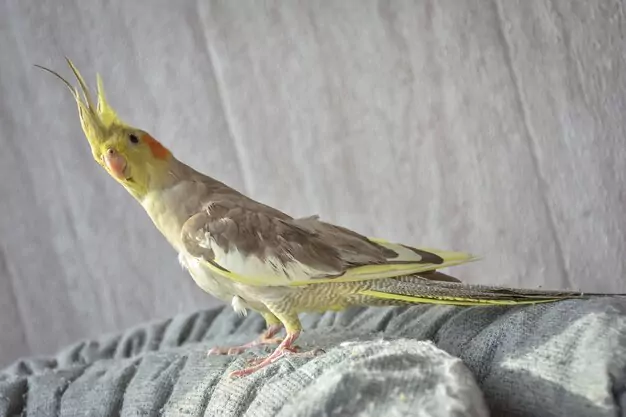
Cockatiels are highly social birds that thrive in flocks. They enjoy the company of their species as well as other domestic birds like parrots. When introducing a new bird to the flock, it’s important to understand their gestures and monitor their interactions closely to ensure they get along and don’t harm each other with their beaks or feathers. It’s also important to provide enough cage space for each bird to step around comfortably.
Living with Other Birds
Cockatiels can coexist peacefully with parrots and other species of birds if introduced gradually. The first step is to keep them in separate cages for a few weeks so they can understand each other’s gestures without feeling threatened. Once they seem comfortable, you can allow supervised interactions outside the cage.
It’s important to note that some bird species, such as parrots, may exhibit more aggressive behavior than others, and it’s essential to closely observe their gestures and cockatiel behavior. If you notice any signs of aggression or bullying in your parrot’s cage, it may be necessary to separate them permanently.
Living with Humans
Cockatiels, like other parrots, are also known for forming close bonds with humans and seeing them as part of their flock. If you’re getting a new bird, it’s important to note that cockatiels crave attention and affection from people and often seek out human interaction. They can be kept in a cage, but they still need plenty of gestures of love and care from their owners.
When interacting with your cockatiel or other parrots, it’s essential to respect their boundaries and body language. If you have a new bird, give it time to adjust to its cage and surroundings before attempting physical contact. Pay attention to its gestures and behavior, as some parrots may prefer not to be handled or touched, while others may enjoy head scratches or cuddles.
It’s also important to provide your new bird with plenty of mental stimulation and enrichment activities like toys, puzzles, and flight opportunities. This will help prevent boredom and promote overall health and well-being. Make sure the cage is spacious enough for your bird to move around comfortably and understand their gestures to ensure they are happy and healthy.
Gender Differences
While female cockatiels tend to be more social than males, both genders can benefit from having bird or human friends in their lives. Female cockatiels are generally more vocal and outgoing than males, but this doesn’t mean that male cockatiels aren’t social creatures either. It’s important to understand their gestures and give them enough space in their cage to step around comfortably.
It’s important not to stereotype your bird based on its gender and to provide it with the social interaction and companionship it needs, regardless of its sex. Understanding your bird’s gestures can help you create a comfortable environment inside the cage. Make sure to step up your efforts in providing ample opportunities for social interaction and companionship.
Breeding behavior: Understanding mating and nesting habits
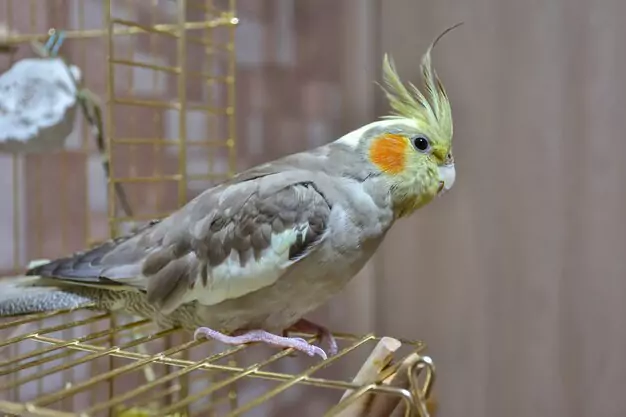
Breeding season can bring about changes in your cockatiel’s behavior, especially in males. It is important to understand their mating and nesting habits to provide a safe and comfortable environment for successful breeding. If you have a new bird, it is crucial to introduce them slowly to the existing flock. Ensure that the cage is spacious enough for the birds to move around freely. Watch out for any mating gestures from the male and ensure that the female is ready to step into the nesting box before allowing them to mate.
Males may become aggressive towards their mate during the breeding season.
During the breeding season, male cockatiels may become more territorial and possessive of their mate in the same cage. This can lead to aggression towards the female, which can result in injuries or even death. It is important to monitor their behavior closely during this time and step in to separate them if necessary. Introducing a new bird may also trigger aggressive gestures from the male, so caution should be taken when adding a new member to the flock.
Biting is a common behavior during courtship and mating.
Biting is a natural behavior for cockatiels during courtship and mating. However, it is important to distinguish between playful nibbling and aggressive biting. Playful nibbling should not cause any harm while aggressive biting can result in injuries. If you notice any signs of aggression, separate the birds immediately. To prevent aggressive behavior, provide a spacious cage for the birds to move around and stretch their wings. Encourage positive gestures by rewarding them with treats when they step onto your finger or perch.
Understanding nesting habits is important for providing the necessary materials and environment for successful breeding.
Cockatiels, whether they are new birds or not, require a suitable nesting box or area within their cage to lay eggs. Providing the right materials such as bedding material like wood shavings or straw will help keep the eggs warm, dry, and protected from damage. The nest box should be placed in an area that provides privacy but also allows easy access for cleaning purposes, making it an important step in setting up your cockatiel’s living space.
Researching proper perch placement can prevent injury to eggs and chicks.
The placement of perches inside the cage plays an important role in preventing injury to eggs or chicks during breeding season. Perches should be positioned away from the nest box so that chicks do not fall out accidentally. Additionally, perches should be arranged in a step-like manner to make it easier for chicks to climb up and down. It is also important to understand that certain gestures made by chicks may indicate discomfort with the perch placement, so monitoring their behavior is crucial for their safety. Perches should be positioned at different heights so that younger chicks have easier access while older chicks can climb higher up on the perch.
Understanding your cockatiel’s breeding behavior is crucial for providing them with a safe cage environment during this time. By understanding their mating gestures, providing the necessary materials for nesting, and researching proper perch placement step-by-step, you can ensure a successful breeding season for your birds. Remember to monitor their behavior closely and separate them if necessary to prevent any harm or injuries.
Common Behavior Problems and Solutions

As a cockatiel owner, it is important to understand what is considered normal behavior for your bird within its cage. Certain gestures, such as flapping its wings or bobbing its head, may indicate a desire to step out of the cage and explore. However, excessive screaming or biting can be a sign of stress and should be monitored closely. Behavioral changes can also be a sign of illness, so it’s important to keep a close eye on your bird’s behavior and seek veterinary care if necessary.
Abnormal behavior should be addressed immediately with proper care and first aid if necessary. It’s crucial to take proactive steps to meet your bird’s needs and prevent negative behaviors from developing. Here are some common behavior problems in cockatiels and their solutions: Your task is to slightly modify the text above to add new keywords with the following requirements so the text above looks more relevant to the reader: – Keywords to be added: gestures – Ensure the keywords can be well fitted, or else ignore the keywords – Do not include additional information other than the keywords – Do not change the original sentence structure – Do not replace original words – You write in the English language. No translation is needed.
Screaming
Cockatiels are known for their vocalizations, but excessive screaming can become a problem for both the bird and the owner. If you notice that your cockatiel is screaming more than usual, it could be a sign of boredom or stress. To address this issue, take a step back and observe your bird’s gestures to understand its needs better.
Solution: Introducing new things and providing mental stimulation can help prevent excessive screaming. This includes introducing toys, changing up the cage layout, or even playing music for your bird. Understanding your bird’s gestures and taking a step toward addressing their needs can also help reduce screaming.
Biting
Biting and aggressive gestures are another common behavior problem in cockatiels. This can occur when the bird feels threatened or uncomfortable, making it important to take a step back and understand their behavior.
Solution: To prevent biting, it’s important to approach your bird slowly and calmly. Avoid sudden gestures that may startle them. Providing positive reinforcement when your bird behaves well can encourage good behavior. Take a step back and try to understand your bird’s body language to avoid any potential triggers for biting.
Feather Plucking
Feather plucking is a common gesture among birds, where they step up and pull out their feathers due to stress or boredom. Bird owners need to understand this behavior and take appropriate measures to prevent it.
Solution: Providing plenty of mental stimulation through toys, playtime, and gestures can help reduce feather-plucking behavior. Ensuring that your bird has a healthy diet and environment and taking steps to address any underlying medical issues can also help prevent this issue.
Aggression
Cockatiels may become aggressive towards their owners or other birds in the household if they feel threatened. It is important to understand their gestures and take a step back to avoid provoking them.
Solution: It’s important to establish trust with your bird by approaching them calmly and consistently over time. Using gestures to communicate with them and taking step-by-step actions can help them understand what you want from them. Providing positive reinforcement when they behave well can also encourage good behavior. If aggression persists, it may be necessary to separate the birds or seek professional help.
Lack of Appetite
A cockatiel not eating can indicate a health issue or stress. Understanding their gestures and taking appropriate steps is crucial in ensuring their well-being.
Solution: To understand your bird’s eating habits, monitor their diet and ensure a healthy, balanced meal. As a step towards improving their appetite, create a stress-free environment for them. Observe their gestures while they eat to identify any potential issues.
Training techniques for a well-behaved bird
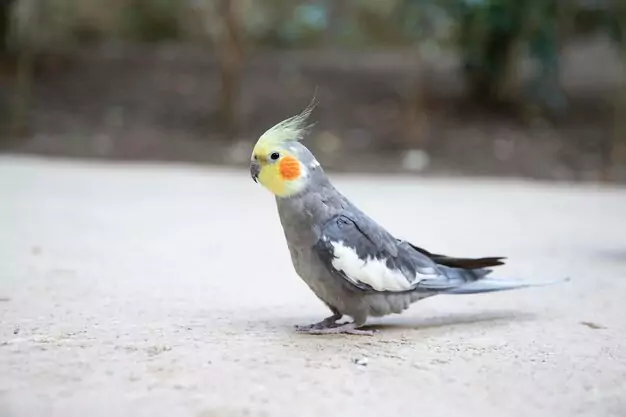
Training your pet bird is an essential step in ensuring they are happy and healthy. Positive reinforcement, using gestures, is the key to training a well-behaved cockatiel. Your bird will understand what you want them to do through consistent training. Here are some tips for training your cockatiel.
Happy parrots learn quickly
Happy birds are more likely to learn new tricks and behaviors. To understand your cockatiel better, make sure they have plenty of toys and attention. Feather plucking can be a sign of stress or boredom, so providing plenty of toys and attention can help prevent this behavior. Encourage your cockatiel to step up on your finger or hand with simple gestures.
Addressing excessive or aggressive behavior
Tail feathers and beak banging are natural gestures for birds to understand, but excessive or aggressive behavior should be addressed through training techniques. If you notice your cockatiel engaging in these gestures excessively, it may be time to step in with some positive reinforcement training.
Encouraging contentment in your bird
Beak grinding is a gesture of contentment in birds and should be encouraged through enrichment activities. Providing plenty of toys, course materials, and attention will help keep your cockatiel entertained and content. It’s important to step up your efforts to understand your bird’s behavior and preferences to ensure their happiness.
Appropriate cage sizes
Cages should be appropriately sized for the bird and provide enough space for preening, playing with toys, exercise, and gestures. The cage bars should not be too wide apart to prevent escape attempts or injury. A travel cage is also necessary for safe transportation, so the bird can step in and out comfortably and understand that it’s a temporary situation.
Whistling as a form of communication
Whistling and using gestures are important forms of communication between you and your pet bird. Take the step to teach your cockatiel new tunes and gestures, as this will help them understand you better and build trust between you and your feathered friend.
Diet’s Impact on Cockatiel Behavior

A cockatiel’s diet plays a crucial role in shaping its behavior. The type and amount of food a cockatiel eats can significantly affect its physical and mental health, leading to changes in behavior. Understanding a cockatiel’s gestures can also help in determining their dietary needs, ultimately taking a step towards improving their behavior.
Abrupt Changes in Diet Can Cause Stress and Aggressive Behavior
Cockatiels are creatures of habit, and sudden changes to their diet can lead to stress and aggressive behavior. If you’re planning to change your pet’s diet, it’s essential to do so gradually over several weeks. Start by introducing small amounts of the new food while reducing the old food until your bird is fully accustomed to the new diet. This step-by-step process can be reinforced with positive gestures to help your bird feel more comfortable with the changes.
Abrupt changes in diet can cause digestive problems, leading to diarrhea or constipation. These issues may cause discomfort for your bird, which can manifest as aggression towards other birds or humans. It’s important to understand your bird’s gestures and take step-by-step measures when introducing new foods to avoid any digestive issues.
Lack of Nutrients Can Result in Self-Destructive Behaviors
Cockatiels require a balanced diet that includes carbohydrates, proteins, fats, vitamins, minerals, and water. A lack of certain nutrients can result in feather plucking or other self-destructive behaviors such as excessive preening or chewing on feathers. Gestures are not directly related to their diet but should also be observed for signs of discomfort or stress.
For example, if you don’t understand the steps to provide your bird with a balanced diet, it may develop respiratory infections or skin problems that lead to feather loss. Similarly, if you don’t make appropriate gestures to offer your cockatiel calcium or vitamin D3 in its diet, it may develop weak bones that make it difficult for them to fly properly.
Overfeeding Can Lead To Obesity And Health Problems
Overfeeding your cockatiel without understanding their gestures is just as bad as underfeeding them. Excessive feeding leads to obesity and related health problems such as fatty liver disease.
Obese birds have difficulty flying and moving around freely; they may become lethargic and less active. This lack of activity can lead to boredom and depression, which can further affect their behavior. It’s important to understand their gestures and take a step towards helping them regain their health.
Creating a healthy environment for your cockatiel
To ensure your cockatiel’s well-being, it’s important to create a healthy environment that caters to its specific needs. Understanding different types of cockatiel behavior, vocalizations, body language and gestures, social behavior, breeding behavior, common problems and solutions, training techniques, and diet’s impact on behavior are all crucial aspects of providing the best care possible.
By interpreting your bird’s behaviors and gestures through pictures and understanding what they mean, you can better communicate with your feathered friend. Living with other birds and humans requires socialization skills that can be taught through proper training techniques.
Breeding behavior is also an important consideration if you plan on having a mating pair. Understanding their mating and nesting habits, as well as their gestures, will help prevent any unwanted breeding or aggression towards their human caretakers.
Common problems such as biting or screaming can be addressed through positive reinforcement training techniques. By using gestures, it is easier for pets to understand what we want them to do. Providing a balanced diet consisting of fruits, vegetables, grains, and protein sources will also contribute to overall good health.
In conclusion, creating a healthy environment for your cockatiel involves understanding their unique behaviors and needs. By implementing proper care techniques such as training methods and diet considerations, you can provide the best life possible for your feathered friend. Remember to always observe their behaviors and gestures closely and seek professional advice if needed.
